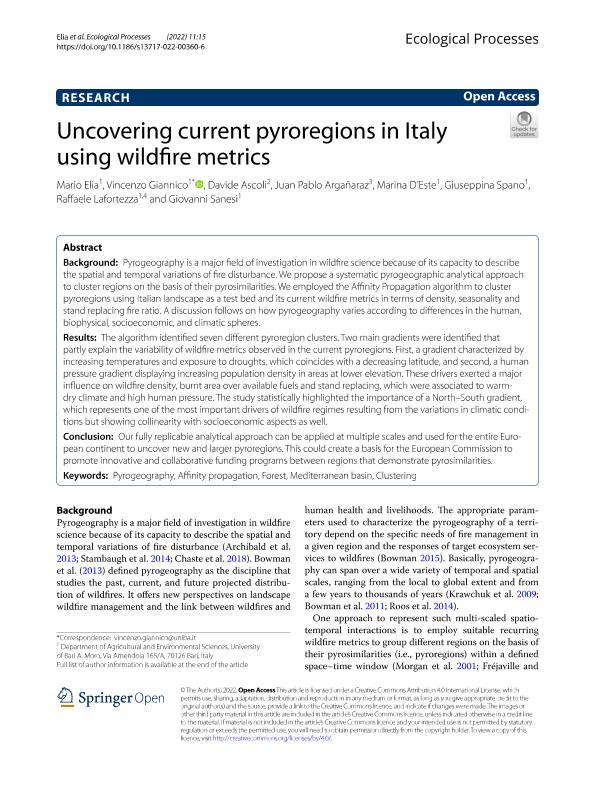Mostrar el registro sencillo del ítem
dc.contributor.author
Elia, Mario
dc.contributor.author
Giannico, Vincenzo
dc.contributor.author
Ascoli, Davide
dc.contributor.author
Argañaraz, Juan Pablo

dc.contributor.author
D'Este, Marina
dc.contributor.author
Spano, Giuseppina
dc.contributor.author
Lafortezza, Raffaele
dc.contributor.author
Sanesi, Giovanni
dc.date.available
2023-02-10T11:12:21Z
dc.date.issued
2022-12
dc.identifier.citation
Elia, Mario; Giannico, Vincenzo; Ascoli, Davide; Argañaraz, Juan Pablo; D'Este, Marina; et al.; Uncovering current pyroregions in Italy using wildfire metrics; Springer; Ecological Processes; 11; 1; 12-2022; 1-17
dc.identifier.issn
2192-1709
dc.identifier.uri
http://hdl.handle.net/11336/187560
dc.description.abstract
Background: Pyrogeography is a major field of investigation in wildfire science because of its capacity to describe the spatial and temporal variations of fire disturbance. We propose a systematic pyrogeographic analytical approach to cluster regions on the basis of their pyrosimilarities. We employed the Affinity Propagation algorithm to cluster pyroregions using Italian landscape as a test bed and its current wildfire metrics in terms of density, seasonality and stand replacing fire ratio. A discussion follows on how pyrogeography varies according to differences in the human, biophysical, socioeconomic, and climatic spheres. Results: The algorithm identified seven different pyroregion clusters. Two main gradients were identified that partly explain the variability of wildfire metrics observed in the current pyroregions. First, a gradient characterized by increasing temperatures and exposure to droughts, which coincides with a decreasing latitude, and second, a human pressure gradient displaying increasing population density in areas at lower elevation. These drivers exerted a major influence on wildfire density, burnt area over available fuels and stand replacing, which were associated to warm-dry climate and high human pressure. The study statistically highlighted the importance of a North–South gradient, which represents one of the most important drivers of wildfire regimes resulting from the variations in climatic conditions but showing collinearity with socioeconomic aspects as well. Conclusion: Our fully replicable analytical approach can be applied at multiple scales and used for the entire European continent to uncover new and larger pyroregions. This could create a basis for the European Commission to promote innovative and collaborative funding programs between regions that demonstrate pyrosimilarities.
dc.format
application/pdf
dc.language.iso
eng
dc.publisher
Springer

dc.rights
info:eu-repo/semantics/openAccess
dc.rights.uri
https://creativecommons.org/licenses/by/2.5/ar/
dc.subject
AFFINITY PROPAGATION
dc.subject
CLUSTERING
dc.subject
FOREST
dc.subject
MEDITERRANEAN BASIN
dc.subject
PYROGEOGRAPHY
dc.subject.classification
Ecología

dc.subject.classification
Ciencias Biológicas

dc.subject.classification
CIENCIAS NATURALES Y EXACTAS

dc.title
Uncovering current pyroregions in Italy using wildfire metrics
dc.type
info:eu-repo/semantics/article
dc.type
info:ar-repo/semantics/artículo
dc.type
info:eu-repo/semantics/publishedVersion
dc.date.updated
2023-02-09T15:37:37Z
dc.journal.volume
11
dc.journal.number
1
dc.journal.pagination
1-17
dc.journal.pais
Suiza

dc.description.fil
Fil: Elia, Mario. Università degli Studi di Bari; Italia
dc.description.fil
Fil: Giannico, Vincenzo. Università degli Studi di Bari; Italia
dc.description.fil
Fil: Ascoli, Davide. Università di Torino; Italia
dc.description.fil
Fil: Argañaraz, Juan Pablo. Comision Nacional de Actividades Espaciales. Instituto de Altos Estudios Espaciales "Mario Gulich"; Argentina. Consejo Nacional de Investigaciones Científicas y Técnicas. Centro Científico Tecnológico Conicet - Córdoba; Argentina
dc.description.fil
Fil: D'Este, Marina. Università degli Studi di Bari; Italia
dc.description.fil
Fil: Spano, Giuseppina. Università degli Studi di Bari; Italia
dc.description.fil
Fil: Lafortezza, Raffaele. Università degli Studi di Bari; Italia
dc.description.fil
Fil: Sanesi, Giovanni. Università degli Studi di Bari; Italia
dc.journal.title
Ecological Processes
dc.relation.alternativeid
info:eu-repo/semantics/altIdentifier/url/https://ecologicalprocesses.springeropen.com/articles/10.1186/s13717-022-00360-6
dc.relation.alternativeid
info:eu-repo/semantics/altIdentifier/doi/http://dx.doi.org/10.1186/s13717-022-00360-6
Archivos asociados
